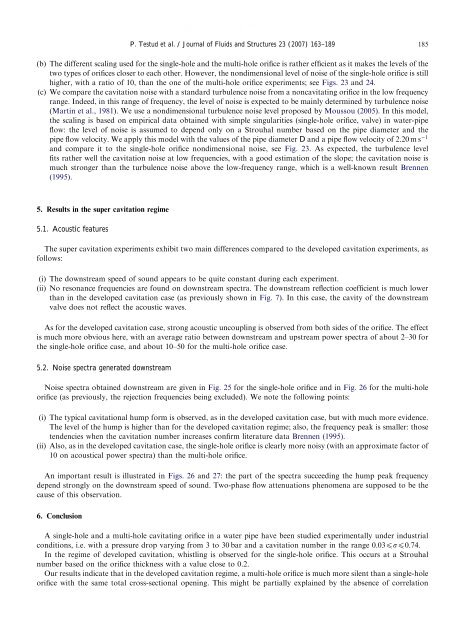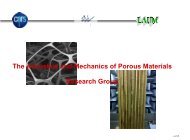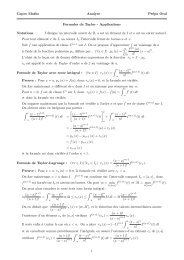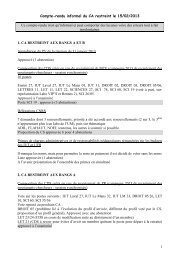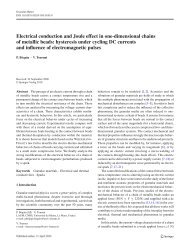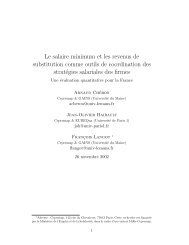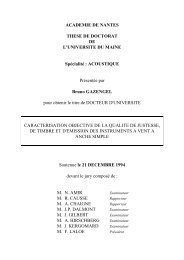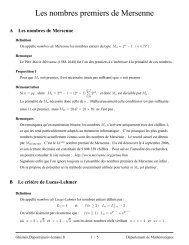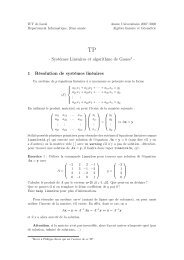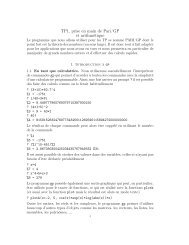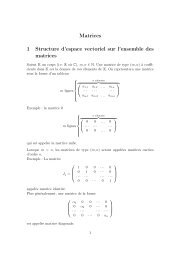Noise generated by cavitating single-hole and multi-hole orifices in ...
Noise generated by cavitating single-hole and multi-hole orifices in ...
Noise generated by cavitating single-hole and multi-hole orifices in ...
Create successful ePaper yourself
Turn your PDF publications into a flip-book with our unique Google optimized e-Paper software.
ARTICLE IN PRESSP. Testud et al. / Journal of Fluids <strong>and</strong> Structures 23 (2007) 163–189 185(b) The different scal<strong>in</strong>g used for the <strong>s<strong>in</strong>gle</strong>-<strong>hole</strong> <strong>and</strong> the <strong>multi</strong>-<strong>hole</strong> orifice is rather efficient as it makes the levels of thetwo types of <strong>orifices</strong> closer to each other. However, the nondimensional level of noise of the <strong>s<strong>in</strong>gle</strong>-<strong>hole</strong> orifice is stillhigher, with a ratio of 10, than the one of the <strong>multi</strong>-<strong>hole</strong> orifice experiments; see Figs. 23 <strong>and</strong> 24.(c) We compare the cavitation noise with a st<strong>and</strong>ard turbulence noise from a non<strong>cavitat<strong>in</strong>g</strong> orifice <strong>in</strong> the low frequencyrange. Indeed, <strong>in</strong> this range of frequency, the level of noise is expected to be ma<strong>in</strong>ly determ<strong>in</strong>ed <strong>by</strong> turbulence noise(Mart<strong>in</strong> et al., 1981). We use a nondimensional turbulence noise level proposed <strong>by</strong> Moussou (2005). In this model,the scal<strong>in</strong>g is based on empirical data obta<strong>in</strong>ed with simple s<strong>in</strong>gularities (<strong>s<strong>in</strong>gle</strong>-<strong>hole</strong> orifice, valve) <strong>in</strong> water-pipeflow: the level of noise is assumed to depend only on a Strouhal number based on the pipe diameter <strong>and</strong> thepipe flow velocity. We apply this model with the values of the pipe diameter D <strong>and</strong> a pipe flow velocity of 2:20 m s 1<strong>and</strong> compare it to the <strong>s<strong>in</strong>gle</strong>-<strong>hole</strong> orifice nondimensional noise, see Fig. 23. As expected, the turbulence levelfits rather well the cavitation noise at low frequencies, with a good estimation of the slope; the cavitation noise ismuch stronger than the turbulence noise above the low-frequency range, which is a well-known result Brennen(1995).5. Results <strong>in</strong> the super cavitation regime5.1. Acoustic featuresThe super cavitation experiments exhibit two ma<strong>in</strong> differences compared to the developed cavitation experiments, asfollows:(i) The downstream speed of sound appears to be quite constant dur<strong>in</strong>g each experiment.(ii) No resonance frequencies are found on downstream spectra. The downstream reflection coefficient is much lowerthan <strong>in</strong> the developed cavitation case (as previously shown <strong>in</strong> Fig. 7). In this case, the cavity of the downstreamvalve does not reflect the acoustic waves.As for the developed cavitation case, strong acoustic uncoupl<strong>in</strong>g is observed from both sides of the orifice. The effectis much more obvious here, with an average ratio between downstream <strong>and</strong> upstream power spectra of about 2–30 forthe <strong>s<strong>in</strong>gle</strong>-<strong>hole</strong> orifice case, <strong>and</strong> about 10–50 for the <strong>multi</strong>-<strong>hole</strong> orifice case.5.2. <strong>Noise</strong> spectra <strong>generated</strong> downstream<strong>Noise</strong> spectra obta<strong>in</strong>ed downstream are given <strong>in</strong> Fig. 25 for the <strong>s<strong>in</strong>gle</strong>-<strong>hole</strong> orifice <strong>and</strong> <strong>in</strong> Fig. 26 for the <strong>multi</strong>-<strong>hole</strong>orifice (as previously, the rejection frequencies be<strong>in</strong>g excluded). We note the follow<strong>in</strong>g po<strong>in</strong>ts:(i) The typical cavitational hump form is observed, as <strong>in</strong> the developed cavitation case, but with much more evidence.The level of the hump is higher than for the developed cavitation regime; also, the frequency peak is smaller: thosetendencies when the cavitation number <strong>in</strong>creases confirm literature data Brennen (1995).(ii) Also, as <strong>in</strong> the developed cavitation case, the <strong>s<strong>in</strong>gle</strong>-<strong>hole</strong> orifice is clearly more noisy (with an approximate factor of10 on acoustical power spectra) than the <strong>multi</strong>-<strong>hole</strong> orifice.An important result is illustrated <strong>in</strong> Figs. 26 <strong>and</strong> 27: the part of the spectra succeed<strong>in</strong>g the hump peak frequencydepend strongly on the downstream speed of sound. Two-phase flow attenuations phenomena are supposed to be thecause of this observation.6. ConclusionA <strong>s<strong>in</strong>gle</strong>-<strong>hole</strong> <strong>and</strong> a <strong>multi</strong>-<strong>hole</strong> <strong>cavitat<strong>in</strong>g</strong> orifice <strong>in</strong> a water pipe have been studied experimentally under <strong>in</strong>dustrialconditions, i.e. with a pressure drop vary<strong>in</strong>g from 3 to 30 bar <strong>and</strong> a cavitation number <strong>in</strong> the range 0:03psp0:74.In the regime of developed cavitation, whistl<strong>in</strong>g is observed for the <strong>s<strong>in</strong>gle</strong>-<strong>hole</strong> orifice. This occurs at a Strouhalnumber based on the orifice thickness with a value close to 0.2.Our results <strong>in</strong>dicate that <strong>in</strong> the developed cavitation regime, a <strong>multi</strong>-<strong>hole</strong> orifice is much more silent than a <strong>s<strong>in</strong>gle</strong>-<strong>hole</strong>orifice with the same total cross-sectional open<strong>in</strong>g. This might be partially expla<strong>in</strong>ed <strong>by</strong> the absence of correlation


